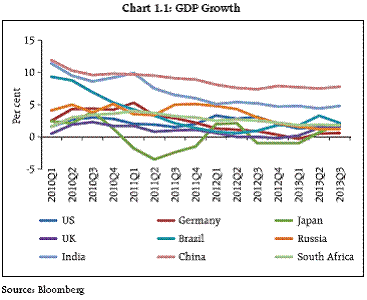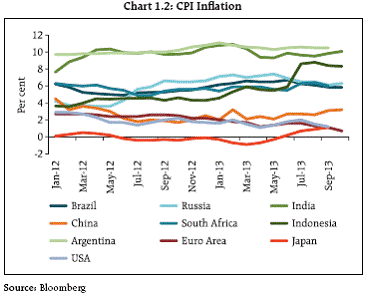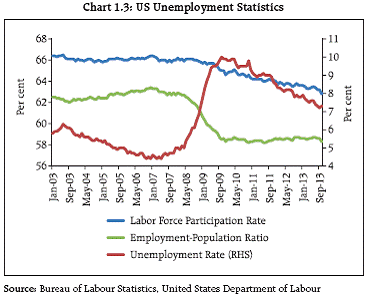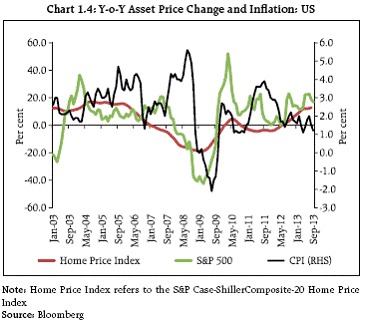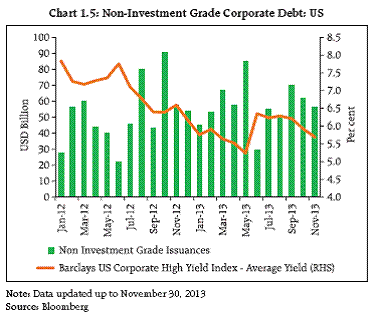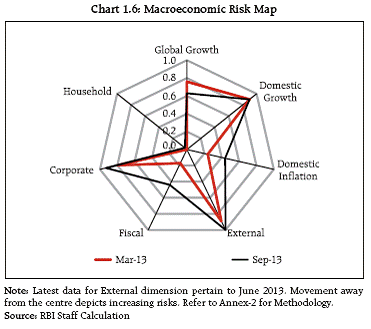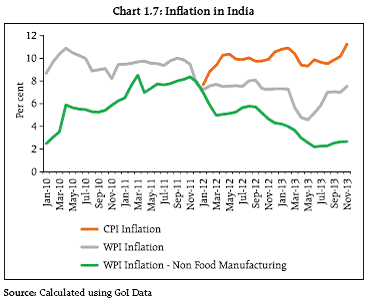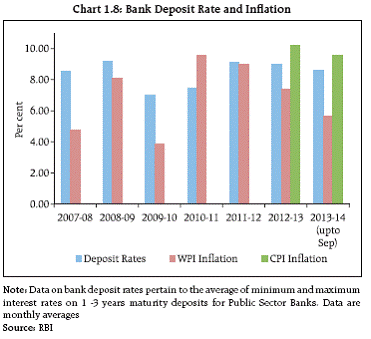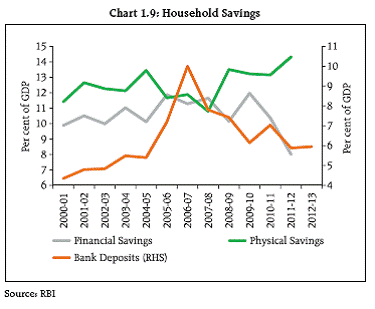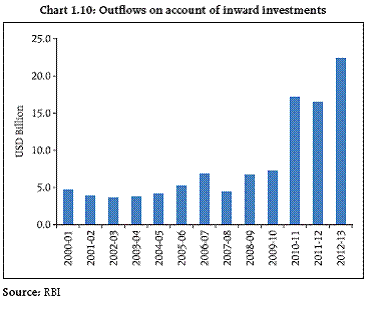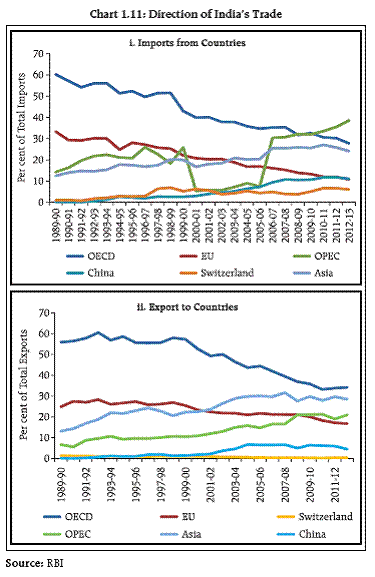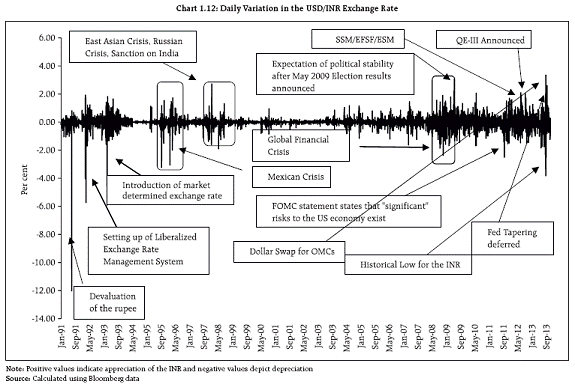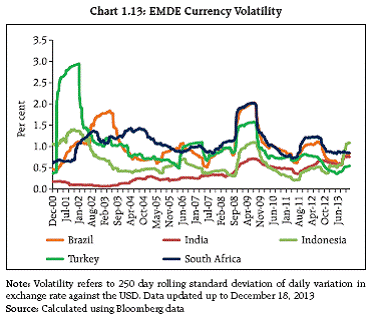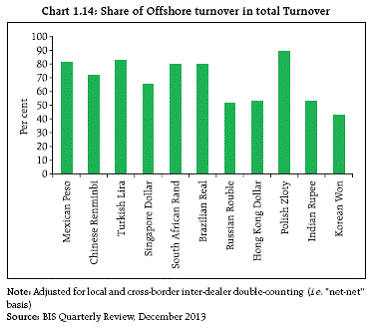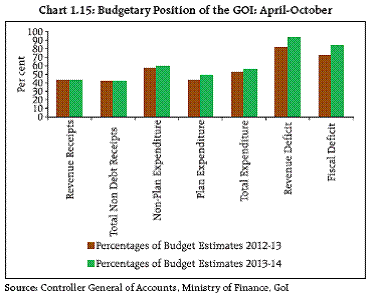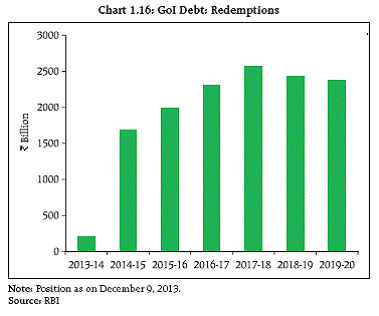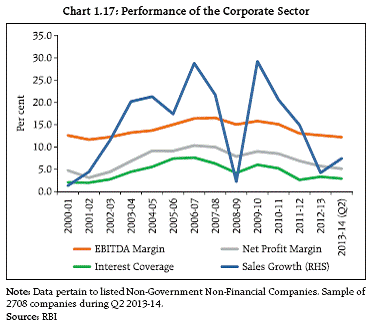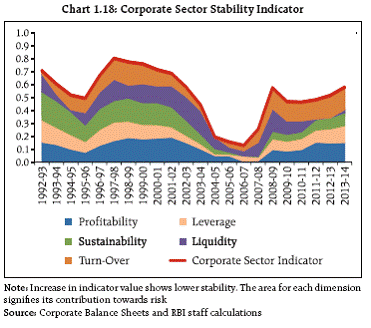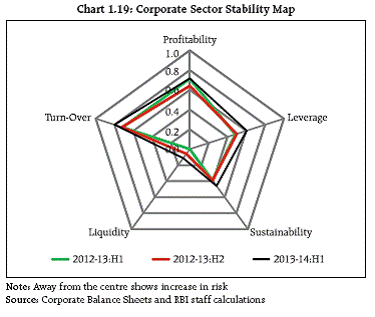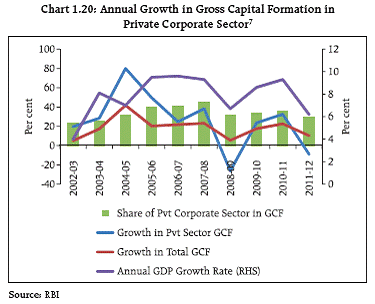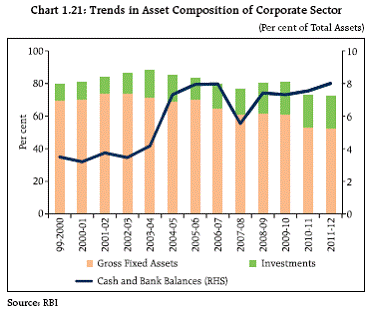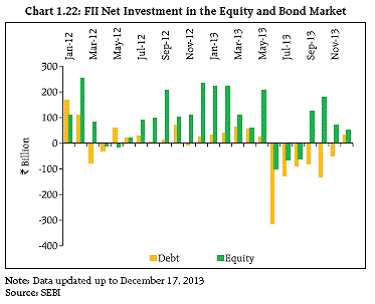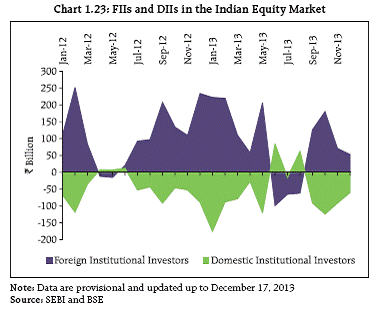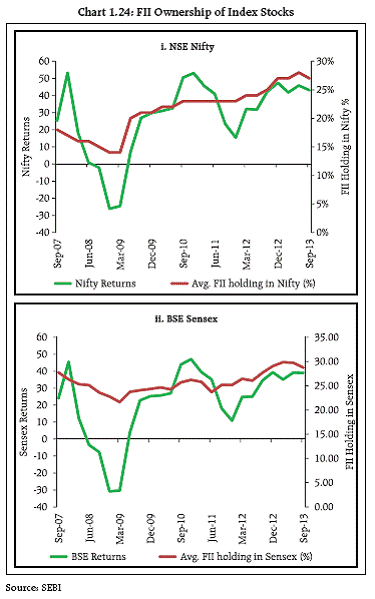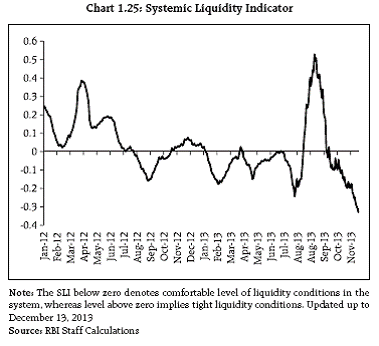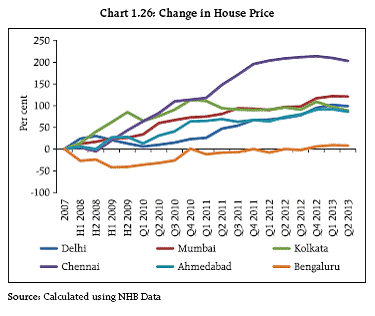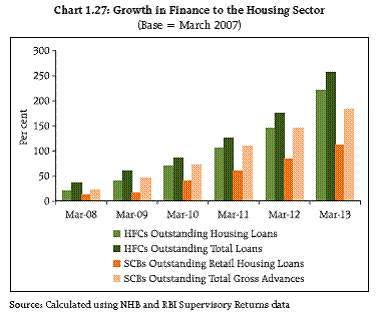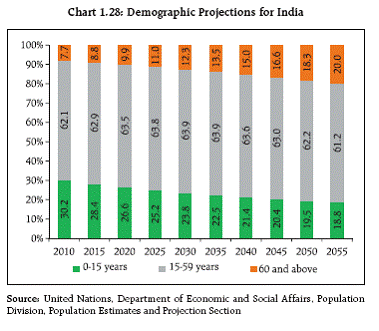 IST,
IST,
Chapter I : Macro-Financial Risks
| The US Federal Reserve (Fed) announced tapering in its bond purchase programme on December 18, 2013. Financial markets had been expecting this move since the first indication of such action in May 2013. Initial reaction to the tapering announcement has been positive. Growth differential between advanced economies (AEs) and emerging market and developing economies (EMDEs) has been narrowing, while the inflation differential has been widening. The resultant risk-return dynamics seem to favour AEs, thereby increasing the vulnerability of the EMDEs. India utilised the delay in tapering to bring about adjustment in the current account deficit (CAD) and built buffers by replenishing its foreign exchange reserves. Consequently, external sector risks have been considerably reduced and the effect of the tapering on the economy is expected to be limited and short lived. However, macroeconomic adjustment is far from complete, with persistence of high inflation amidst growth slowdown. Fall in domestic savings rate and high fiscal deficit continue to pose challenges for India. The Indian economy staged a small recovery in the second quarter of the current fiscal year with growth at 4.8 per cent, an improvement over the previous quarter’s 4.4 per cent with improvement in growth spread across sectors. On the external front, the CAD moderated sharply to 1.2 per cent of GDP during Q2 2013-14 due to a decline in the trade deficit. Boom period expansions that led to excess capacities and structural impediments continue to weigh on corporate performance. Asset composition of corporate balance-sheets shows a shift towards increased financial investments. Foreign Institutional Investors (FIIs) continue to remain significant players in the domestic equity markets, despite some fall in their ownership of index stocks after June 2013. As such, entities with equity market exposure need to brace for any future volatilities which might result from perceived changes in relative returns across markets. Global Backdrop 1.1 The previous Financial Stability Report (FSR) was published against the backdrop of uncertainty and volatility unleashed by the US Federal Reserves’ (Fed) intent of tapering its bond purchases programme, first indicated in May 2013 and reaffirmed in June 2013. Emerging market and developing economies (EMDEs) witnessed huge outflows from their debt and equity markets and large depreciation of their currencies following the May 2013 announcement. Apart from policy measures to address adverse current account balances, various capital control measures had to be resorted to by affected economies to stem the sharp fall of their currencies. A semblance of stability returned to financial markets when fears of tapering receded in September 2013. While the May – June events offered a preview of what would follow a change in ultra-easy monetary policies in advanced economies (AEs), the respite offered time to policy makers to improve the resilience of their economies to face the effects of tapering, eventually with less deleterious impact. 1.2 This FSR is being finalised at a time when the Fed has laid to rest the uncertainty on timing of the exit. This time around, financial markets seem to have factored-in the tapering and have reacted generally positively to the announcement. The Fed’s for ward guidance of maintaining highly accommodative stance of monetary policy for a considerable period of time after the asset purchase program ends and further strengthening of US economic recovery also provided more clarity on the movement of policy interest rates. With the Fed announcing a tapering of USD 10 billion, beginning in January 2014, in its monthly USD 85 billion bond purchase programme, volatility in financial markets henceforth will be conditioned by changes in the pace of tapering. 1.3 In the meanwhile, Euro Area has made progress in moving towards a banking union. Declining inflation and tepid growth in the region necessitated reduction in policy rates. There have been concerns that Germany’s persistent and large current account surplus might be hampering ‘rebalancing’ in the Euro Area. Economic policies in Japan seem to have improved sentiments and boosted growth. Growth in China during Q3 2013 has been better than expectations. Growth-Inflation Dynamics - Challenges for EMDEs 1.4 Realignment of global growth is likely to result in volatile cross-border flows, thus posing threats to financial stability especially in EMDEs. With the growth differential between AEs and EMDEs narrowing (Chart 1.1), large gyrations in financial markets are likely with every re-pricing of risk. Relatively slower growth in EMDEs may tilt the risk-return structure in favour of AEs which could lead to capital outflows from EMDEs when global liquidity falls. Going forward, potential debt ceiling brinksmanship in the US in early 2014 could re-enact the events witnessed earlier. 1.5 Most AEs are faced with low and falling inflation and are constrained to keep interest rates low or near zero for an extended period. Some EMDEs like Argentina, India and Indonesia among others are experiencing high inflation (Chart 1.2). The resultant inflation differential between some of the EMDEs and AEs is a potential source of volatility in exchange rates as capital flows could change direction abruptly. In this context, it is imperative for India to contain inflation and strengthen the economy before further reversal of easy money policies in the AEs materialises. Inflation management remains a major challenge for India in an environment of sluggish growth and significant differential between the food price inflation and manufacturing prices inflation. 1.6 With unemployment rate falling in the US, phased withdrawal from the Fed’s bond purchase programme has materialised. However, the fall in unemployment rate has come on the back of a fall in the labour force participation rate as well as near stagnant employment-population ratio at a low level (Chart 1.3). In addition, even with large monetary policy accommodation, inflation as measured by the annual change in price index for personal consumption expenditures in the US is below the Fed’s target of 2 per cent and could pose challenges for growth going forward. The Euro Area has similar concerns with negative GDP growth (Y-o-Y) during Q3 2013 and inflation much below the European Central Bank’s (ECB) target, prompting a policy rate cut. 1.7 Easy money policies in AEs, however, have been pushing up asset prices with little perceptible effect on consumer prices (Chart 1.4). Search for yield continues unabated after having moderated briefly during mid-2013 (Chart 1.5). Paradoxical as it may seem, the response to global financial crisis (GFC) which was, to a large extent, perpetuated by an extended period of low interest rates and excess liquidity, has once again been extended periods low interest rates and easy liquidity. While initial unconventional policies contributed to improved market functioning, keeping interest rates low to artificially pump prime markets could accentuate the vulnerabilities already built in. Some of the vulnerabilities played out after the announcement of tapering of quantitative easing (QE) by the Fed in May 2013. Domestic Economy Macro Economic Risks 1.8 Against this backdrop, macro-economic risks facing the Indian economy increased (Chart 1.6) between March 2013 and September 2013 though some risks have fallen since then. 1.9 Real GDP growth in India moderated to 5.0 per cent during 2012-13 from 6.2 per cent in 2011-12, and slackened further to 4.4 per cent during Q1 2013-14 before improving marginally to 4.8 per cent during Q2 2013-14. Sub sectors such as agriculture, manufacturing, electricity, construction and financing and business services witnessed an improvement in performance during Q2 vis-a-vis the corresponding period of the previous year, in contrast to the broad based deceleration in the previous quarter. On the whole, GDP growth rate in the first half of 2013-14 (H1) was placed at 4.6 per cent as compared to 5.3 per cent in H1 2012-13. Supply constraints and high inflation, however, continued to weigh on the growth process. Aggregate demand during Q2 2013-14 picked up primarily on account of exports and, to some extent, fixed investment. While private final consumption expenditure (PFCE) decelerated during Q2, government final consumption expenditure (GFCE) declined by 1.1 per cent as compared with a strong growth of over 10 per cent in the previous quarter. 1.10 A modest improvement in growth is envisaged in the second half of 2013-14, on the back of a good monsoon which has boosted the kharif prospects. Exports have picked up with exchange rate adjustment, and global growth is expected to improve from 2.9 per cent in 2013 to 3.6 per cent in 20141. On the policy front, the government has initiated action in clearing projects especially in the infrastructure sector, which is expected to improve the overall investment climate. These measures would, however, take time to translate into activity at the ground-level. The revival of large stalled projects cleared by the Cabinet Committee on Investment are likely to buoy investment and overall activity towards the end of fiscal year. The downside risks to the domestic growth stem from persistently high inflation (Chart 1.7), relatively high fiscal deficit and consequent pressure on interest rates and uncertainty in the global environment. 1.11 The disinflationary effect of growth slowdown has not been witnessed as the pass-through of rupee depreciation into prices of manufactured products has been taking place, while food and fuel inflation have been elevated in the absence of supply side response and high wage inflation. Wholesale price index (WPI) inflation remained around/above 7 per cent for the fourth consecutive month in November 2013. Retail inflation measured by the consumer price index (CPI) also rose sharply and crossed the 11 per cent mark in November 2013. Even as some moderation is expected in food inflation going forward, persistence of retail inflation remains a concern. To address the inflationary concerns and to strengthen the environment for sustainable growth by fostering macroeconomic and financial stability, monetary policy was tightened in September 2013 and October 2013 by a cumulative 50 basis points hike in repo rate. Inflation and Household Financial Savings 1.12 In addition to the uncertainty which persistently high inflation brings to the business environment, it also adversely affects purchasing power, consumption and inflation adjusted returns on assets. This is particularly true of inflation adjusted returns on bank deposits (Chart 1.8). 1.13 One possible consequence of this has been a fall in net financial assets of households as a percentage of GDP. Money saved in bank deposits as a percentage of GDP by households has also fallen from the highs of the mid-2000s (Chart 1.9). On the other hand, non-financial assets seemed to have enabled households to earn relatively better inflation adjusted returns. Further, differential tax treatment of bank deposits, capital market instruments and non-financial assets like real-estate also creates a bias against bank deposits, which account for a significant proportion of household financial assets. A fall in savings has widened the saving-investment (S-I) gap increasing the economy’s dependence on external capital. Recent measures such as the re-introduction of inflation indexed bonds (IIBs) and introduction of CPI linked saving certificates for retail customers are part of the strategy to encourage investors to invest in financial assets. Further Securities and Exchange Board of India (SEBI) recently brought out the draft consultation paper on Real Estate Investment Trusts (REITs). External Sector Vulnerabilities 1.14 Against the backdrop of a large CAD and dependence on volatile capital flows to fund it, the Indian rupee had depreciated following the Fed’s May 2013 indication of possible tapering in its bond purchase programme. There have been significant improvements on the external front since then, following measures initiated by the Government of India (GoI) and the Reserve Bank (Box 1.1). The current account deficit (CAD) during Q2 2013-14 fell sharply to 1.2 per cent of GDP from 4.9 per cent during Q1 2013-14 due to decline in the trade deficit. From July 2013 onwards exports have grown faster than imports. The CAD is expected to be less than 3 per cent of GDP during the current financial year. The increased resilience of the Indian financial markets is evidenced by the positive reaction to the announcement of the commencement of tapering from January 2014 by the Fed. Box 1.1: External Sector Stabilisation Measures Delay in tapering by the Fed following its initial announcement in May 2013, offered time for India and other EMDEs to undertake measures to improve the resilience of their economies to withstand the effects of inevitable tapering. India took a series of co-ordinated measures which seem to have worked well. Some of these are outlined below: Measures to Augment Flows: (i) Exemption of incremental FCNR(B)/NRE deposits with a maturity of three years and above from CRR/SLR requirements, (ii) Exclusion of the incremental FCNR(B)/NRE deposits from adjusted net bank credit for computation of priority sector lending targets, (iii) Liberalisation of FDI norms through review of limits and (or) shifting of selected sectors to the automatic route for FDI, (iv) offering a window to banks to swap the fresh FCNR(B) dollar funds with the Reserve Bank (up to November 30, 2013), (v) Increase in the overseas borrowing limit of banks from 50 to 100 per cent of the unimpaired Tier I capital (with the option of swap with the Reserve Bank), (vi) Permission given to eligible borrowers to avail external commercial borrowings (ECB) under the approval route from their foreign equity holder company for general corporate purposes, Measures to address pressure on the Exchange Rate (i) Foreign exchange swap for public oil marketing companies (OMCs), (ii) Expansion of bi-lateral currency swap arrangement with Japan. Other Measures: (i) Measures to rationalise gold imports (ii) Increase in import duty on gold A sum of USD 34 billion has been received under both the schemes (swap facility for FCNR (B) deposits and bank overseas borrowings) till closure of the scheme at end November 2013. Introduction of the foreign exchange swap for public OMCs contributed to the stability of the exchange rate. With volatility diminishing in the foreign exchange market, OMCs have been meeting all their daily dollar requirements through the market from the last week of November 2013. However, as indicated in the previous FSR, the need for augmenting long term capital inflows, particularly equity flows, remains important. 1.15 In recent years, there has been a significant rise in outflows of investment income in the current account (Chart 1.10). Such outflows include interest payments on commercial borrowings, Non-resident Indian (NRI) deposits and FII investment in debt securities as also outflows on account of FDI. Reliance on external debt for financing high CAD, deregulation of interest rate on NRI deposits and liberalisation of ECB norms have inter alia contributed to the rise in interest payment during this period. While attracting capital inflows to tide over the CAD appears attractive, the long term solution to India’s external problems lies in increasing productivity and export competitiveness. 1.16 Boosting exports in an environment of low global growth could be challenging. However, the strategy of geographical diversification of India’s trade towards Asian economies has been fruitful on this front (Chart 1.11). The focus on rationalising imports, by curtailing non-essential imports, has helped check the growth in CAD. On the positive side, the emerging geopolitics and increased availability of alternative energy sources such as shale gas can possibly have positive impact on the energy import bill. 1.17 The enhanced currency swap arrangement with Japan for USD 50 billion provides an additional buffer to cushion any impact on the Indian rupee. The ratio of short term debt (original maturity) to total debt increased marginally (Table 1.1), but a large part of it being trade related credit is usually rolled over. Further, bilateral trade with countries witnessing increasing trade surplus with India may also reduce the demand for dollars. Fall in gold imports during Q2 2013-14 augurs well for the current account balance. If gold is excluded from the import basket, it improves the import coverage ratio of reserves. On balance, India’s external position appears to be manageable and reserves seem adequate. 1.18 Despite a record CAD and high average inflation (WPI and CPI) the rupee appreciated by about 2 per cent between Q2 2012-13 and Q3 2012-13 (average exchange rate during the quarter over average exchange rate during the previous quarter). Dynamics such as these could have influenced exchange rate movements after May 2013. In general, the Indian rupee has become more volatile after the global financial crises (Chart 1.12).
The INR has been, historically, relatively less volatile compared to some other emerging EMDE currencies (Chart 1.13). In general, there has been an increase in the offshore2 turnover of emerging market currencies during the last few years. For instance according to the Bank of International Settlements (BIS) in the case of some emerging market currencies more than half of average daily turnover, during April 2013, emanated in the offshore market (Chart 1.14). Fiscal Correction – Challenges 1.19 Key deficit indicators of the central government have widened significantly during the first seven months of 2013-14 in comparison to the corresponding period of the previous year (Chart 1.15). Higher plan spending and lower revenue mobilisation resulted in higher gross fiscal deficit (GFD) which was more than 84 per cent of the budget estimate during the first seven months of the current fiscal year. 1.20 The Government, in its Medium Term Fiscal Policy Statement, has stated that plan expenditure has to remain within affordable levels, at least till the process of fiscal consolidation is over. Hence, if the government has to meet its GFD target of 4.8 per cent of GDP, shortfall in receipts and the slippage in major subsidies could lead to a sharp cut back in the plan expenditure, thereby affecting the quality of fiscal adjustment in the near term. 1.21 Revisiting and adherence to the Fiscal Responsibility and Budget Management Act (FRBMA) may boost credibility of the government and improve confidence in the economy. Even from a financial market development perspective, lower government borrowing can go a long way in addressing many structural constraints inhibiting financial market development. To compensate for the reduced capacity of the State in financing desirable capital expenditure, private sector needs to be incentivised to fill the gap mainly through financial market development. 1.22 The average life to maturity of the outstanding GoI’s dated securities at 9.67 years is quite elongated and thus, does not pose any significant rollover risk. Nonetheless, redemption pressure would increase significantly starting from 2014-15 to 2019-20 (Chart 1.16). The demand for long-dated government securities dwindled in the aftermath of the global financial crisis. Thus, a large portion of the government market borrowing programme during 2008-09 and 2009-10 was completed by issuing relatively short and medium-term securities which are maturing between 2014-15 and 2018-19. 1.23 The concern of elevated redemption, however, could be addressed by using buyback/ switches of G-Secs as part of the debt management strategy. These strategies are used extensively for liability management operations across advanced and several emerging market economies (EMEs). The Union Budget 2013-14 has provided `500 billion for buyback and switches and such operations are likely to be undertaken in the last quarter of this fiscal year. This will involve swapping short-term securities with long-term securities in order to reduce the redemption pressure for the maturity buckets from 2014-15 to 2018-19. Corporate Sector 1.24 Indian corporate sector witnessed relatively subdued performance during Q2 2013-14 as evidenced by continuing contraction in net profits and decline in net profit margin (Chart 1.17). Net profits contracted for the second succesive quarter of the current fiscal year even though sales growth increased. Profit margins of the listed non-government non-financial (NGNF) companies remained low since Q2FY12. Profit margin [EBITDA (earnings before interest, tax, depreciation and amortisation) to sales] improved marginally in Q1 2013-14 in comparison with the previous quarter but worsened during Q2 2013-14. Interest coverage ratio, measured by the ratio of EBIT (earnings before interest, tax) to interest payment, recorded a marginal improvement in Q2 2013-14. 1.25 The Corporate Sector Stability Indicator and Map3 presents an overall assessment of changes in underlying conditions and risk factors affecting the stability of the corporate sector. The assessment is based on five dimensions, viz. leverage, liquidity, profitability, sustainability and turnover, during 1992-93 – 2012-13. Results suggest that between 1992-93 and 1995-96 stability of the corporate sector increased (Chart 1.18). Stability deteriorated due to stress in all five dimensions during 1995-96 to 1996-97. The corporate sector remained relatively stressed till 2001-02. Stability improved considerably during 2001-02 - 2007-08. Leverage increased towards the end of this period. Deterioration in all dimensions was witnessed during 2007-08 - 2008-09 with profitability and leverage contributing significantly to overall stress. After marginal improvement in 2009-10, stress increased again. Demand and efficiency factors contributed more towards increase in risks. Sustainability, leverage and profitability also contributed to stress. Though there is some improvement in profitability4 towards the second half of 2012-13, other stability parameters deteriorated further (Chart 1.19). 1.26 The performance of private corporate sector during the last few years has been a concern especially amid falling economic growth. Fall in investments (ratio of gross capital formation to GDP) from 38 per cent in 2007-08 to 35 per cent in 2011-12 is one of the important factors behind slowing growth in the industrial sector. While the global slowdown played an important role, growth in the Indian private sector investments (gross capital formation) had started falling during the years preceding the onset of global financial crisis (Chart 1.20). 1.27 Asset composition of corporates underwent a change during the last two decades. An analysis based on the data5 for a sample of common companies for the period 1999-91 to 2011-12, brings out a clear shift towards increasing share of financial investments in total assets, even as the incremental investment in fixed capital assets like plant and machinery has been slowing6. The contribution of gross fixed assets to the total assets which stood at 74.2 per cent during 2002- 03 gradually declined to 52.6 per cent during 2011-12. During this period, financial investment of the corporates increased to 19.8 per cent of total assets during 2011-12 from 12.4 per cent in 2002-03 (Chart 1.21). This rise in the share of investment to total assets was mainly due to the increasing contribution of investments in the ‘shares and debentures of subsidiaries’ and ‘securities of financial institutions’. The ‘cash and bank balances’ of corporates, which include the ‘fixed deposits with banks’, have also risen during the period under analysis. Equity and Debt Markets 1.28 Subsequent to the Fed’s mid-June 2013 tapering announcement, foreign institutional investors (FIIs) withdrew from the Indian equity and bond markets, but returned as net buyers to the equity market in September 2013, though they were net sellers in the bond market till November 2013 (Chart 1.22). While the actions of domestic and foreign institutions are counterbalancing, the dominance of foreign institutions prevails (Chart 1.23). Between September 2007 and September 2013, FII ownership of the BSE Sensex and the NSE Nifty ranged between 14 per cent – 30 per cent showing a downward trend in the wake of the financial crisis (Chart 1.24). FII holding of index stocks began increasing from March 2009 possibly on the back of easy monetary policy in the AEs, among other factors. However, FII holdings fell after June 2013 on concerns about tapering in QE. The reaction of the Indian equity markets to the recent announcement of tapering of QE has been largely positive suggesting that markets had factored-in the tapering. 1.29 Holding of Indian bonds (government bonds and corporate bonds) by FIIs have fallen from around `1,901 billion as at end March 2013 to around `1,261 billion as on December18, 20138. Thus, risk from large outflows from the bond market have are relatively low. With increased volatility in domestic financial markets after May 2013, the upfront margin prescribed as part of the risk management framework, in the equity cash and derivatives market and currency derivatives segment, was adequate to cover the price movements/volatility on each of the days during April-September 2013 i.e. there was no violation of margin calls. 1.30 Consequent to policy measures initiated by the Reserve Bank to address volatility in the foreign exchange market, the overnight money market rates increased temporarily in line with policy intent and were largely anchored around the Marginal Standing Facility (MSF). Reacting to the tightening measures, yield on short term government securities hardened considerably, which got transmitted across the term structure for a short duration and also increased volatility. Pressures on yields also arose as domestic inflation firmed up and the market priced-in increased probability of global interest rate hardening. Hardening yields resulted in decline in net asset value (NAV) of debt schemes, resulting in substantial redemption pressure for the mutual funds. Banks’ investments as a percentage of total assets under management (AUM) of liquid/money market scheme also declined significantly during the period July 15 - July 31, 2013. As stability returned to the foreign exchange market, the Reserve Bank normalised the exceptional liquidity and monetary measures in a calibrated manner and completed this process by October 2013. Ceteris paribus, this action had a softening impact on bond yields. 1.31 Notwithstanding steep increase in G-Sec yields after policy measures announced in July 2013, the weighted average cost of GoI’s borrowing through nominal dated securities during 2013-14 (up to December 6) remained marginally lower than that during 2012-13 as yields had moderated significantly in the first quarter of 2013-14. With reduction in the MSF rates from September 20, 2013 onwards G-Sec yields started moderating from their elevated levels and volatility also started declining. In addition, systemic liquidity as measured by the systemic liquidity indicator (SLI), began improving from early September 2013 and was comfortable from early October 2013 onwards (Chart 1.25). House Prices 1.32 House prices in some major Indian cities have registered extremely high growth between 2007 and Q2 2013 with some cities registering a doubling of prices during this relatively short time period (Chart 1.26). However, during Q2 2013, house prices in some cities fell while in other cities the growth in house prices moderated. About two-fifth of credit available for retail housing is accounted for by housing finance companies (HFCs). Outstanding loans for housing by HFCs have grown relatively faster than outstanding retail housing loans by scheduled commercial banks (SCBs) and have doubled in four years from 2007 (Chart 1.27). Informal Sector and Wealth Effects 1.34 The increasing relevance of the informal sector and wealth effects of increasing asset prices in the Indian economy, which have grown in significance especially after the initial set of financial sector reforms in the 1990s, can hardly be over-emphasised. However, information on these aspects is scarce. It is imperative to construct robust datasets pertaining to the informal sector from a policy making and developmental planning perspective, while data on wealth effects will be useful mainly to assess the impact on consumption patterns. The Report of the Committee on Unorganised Sector Statistics 2012 recognised that it was important to include and build comprehensive database on various aspects of the informal economy as part of the national statistical system. To achieve this end, several recommendations have been made to improve information on informal sector employment and enterprises among other aspects. Effect of changes in employment and income in the informal sector on consumption and GDP can be tracked and better policy responses can be devised if robust information about this sector is present. Pension System 1.35 India’s pension system for the informal sector is equipped inadequately to handle the rapid ageing, which will pan out in the next few decades. The share of elderly in the population has increased from 5.6 per cent in 1961 to 7.4 per cent in 2001 and is projected to rise to 12.4 per cent by 20269 (Chart 1.28). The absolute numbers will double from 77 million in 2001 to 143 million by 202110. With rising life expectancy and declining fertility, the demographic window of opportunity will close soon and the small cohort of children born during this time will find themselves supporting a large cohort of elderly parents. Besides, this demographic transition occurred in the developed world at higher income levels, while the challenge for India in addressing the coverage gap is compounded by fiscal constraints and the unaffordability of an adequate level of public expenditure for pensions. 1.36 India’s high growth rates in the past two decades have been accompanied by the disturbing trend of increasing informalisation. The informal/ unorganised sector constitutes more than 90 per cent of the workforce and accounts for 50 per cent of the GDP. Tenuous labour market attachment, intermittent incomes, poor access to social security renders the unorganized workers highly vulnerable to economic shocks during their productive years. Coupled with breakdown in traditional family support structures, migration, urbanization and no/inadequate retirement savings the unorganized workers will inevitably face old age poverty and fall back on the tax financed old age pensions like National Social Assistance Programmes (NSAP). The pension schemes under NSAP offer benefits that are below subsistence levels at `200 per month and cater only to the BPL (also see Box 1.2). The recently released Mihir Shah Committee recommendations on pension schemes under NSAP translate to a 12th Plan expenditure exceeding `1,000 billion a figure which appears to be fiscally unsustainable. 1.37 A mono pillar pension system design for 90 per cent unorganized sector workers, consisting only of defined benefit schemes, as is the case today, will have budgetary allocations spiralling out of control and crowd out development expenditure like infrastructure investments and welfare expenditure on health and education. There is growing unanimity that single pillar pension systems (dependent only on tax financed pensions) are unable to address the various risks associated with population ageing. A system design based on multiple pillars which take into account the initial conditions and specific context of the country is better suited to providing protection to the elderly. Pursuant to the passing of the Pension Fund Regulatory and Development Authority Bill, 2013 (PFRDA Bill, 2013) by Parliament in September, 2013, the challenge in further development of the pension sector include aggressively covering the unorganised sector, which accounts for the substantial part of the total labour force and which has no formal pension provision, under NPS, and improvement in the financial literacy levels to educate the subscribers to take appropriate investment decisions based on their risk and return profile so that their pension wealth under NPS could be maximised. The PFRDA Bill, 2013 seeks to vest PFRDA with statutory status in order to help PFRDA perform its regulatory and developmental roles effectively. It is expected that the success of pension reforms will not only help in facilitating the flow of long-term savings for economic development, but would also help establish a credible and financially sustainable social security system in the country. Box 1.2: Planning a Pension System for the Informal Sector Even today the pension budgets, which contain significant expenditure for the old, for states like Bihar, Orissa, Uttar Pradesh and West Bengal account for more than 25 per cent of their revenues. The situation in the North Eastern states is worse with pension budgets accounting for over 50 per cent of revenues in four states of which Nagaland’s expenditure on pensions is more than 135 per cent of its own revenues. The present central and state government budget on pensions exceeds `1,600 billion (BE for 2012-13). It is worth noting that these budgets pertain to the retirees amongst the civil servants who constitute a small percentage of the population. Considering the current budget estimations and commitment towards the pension obligations, a continuous launch of numerous Defined Benefit (DB) schemes with lack of liability computation may prove to be fiscally challenging in an era of increasing life expectancy. The GoI approved on 23rd August 2003 the proposal to implement the budget announcement of 2003-04 relating to introducing a new restructured defined contribution pension system for new entrants to Central Government service, except to Armed Forces, in the first stage, replacing the existing system of defined benefit pension system. The new system was also to be available, on a voluntary basis, to all persons including self employed professionals and others in the unorganised sector. The National Pension System (NPS) was, therefore, created to serve both the Government employees and the private sector workers. While the absence of a country-wide social security system (formal pension coverage being about 12 per cent of the working population), the ageing and social change were important considerations for introducing pension reform in the unorganised sector, fiscal stress of the defined benefit pension system was the major factor driving pension reforms for employees in the organised public sector (Government employees). This had been designed to make a shift from defined-benefit to defined-contribution, putting a cap on government’s liability towards civil servants’ pension, in line with the international practices and the realization of upcoming fiscal stress of pay-as-you-go system. 2Offshore trades refers to all trades executed outside the jurisdiction where a currency is issued 3The five composite indices represent the five dimensions of leverage, liquidity, profitability, sustainability and turnover. Each index, representing an aspect of corporate functioning, takes a value between zero (minimum) and 1 (maximum). Each index is a relative measure during the sample period used for its construction, where a high value implies high risk in that dimension. Therefore, an increase in the value of the index in any particular dimension indicates an increase in risk in that dimension for that period as compared to other periods. A number of ratio-variables are used for each dimension. Each ratio-variable is standardised for the sample period by first converting into a standard normal-variate and then using relative distance method. A composite measure of each dimension is calculated as a simple average of standardised ratios used for that dimension. The overall corporate sector stability indicator is derived as a weighted average of indices of chosen five dimensions, where the weights are derived using principal component analysis. Annual corporate balance sheet data for about 3000 companies have been used. See Annex-2 for detailed methodology. 4Half-yearly balance sheet data of large corporates have been used for 2011-12:H1, 2012-13:H1, 2012-13:H2 and 2013-14:H1. 5This analysis is based on common sample of 765 Non-Government Non-Financial Public Limited Companies 6Also see Chandak, B.L (2013), “Present Economic Crisis Due to Overplaying of Corporate Sector Investment?”, The Indian Banker, October 7GCF Figures at Current market Prices with 2004-05 as base year. GDP figures at factor cost at constant market prices 9Situation Analysis Of The Elderly in India, Central Statistics Office, Ministry of Statistics & Programme Implementation, Government of India, June 2011 10Situation Analysis Of The Elderly in India, Central Statistics Office, Ministry of Statistics & Programme Implementation, Government of India, June 2011. | ||||||||||||||||||||||||||||||||||||||||||||||||||||||||||||||||||||
पेज अंतिम अपडेट तारीख:






